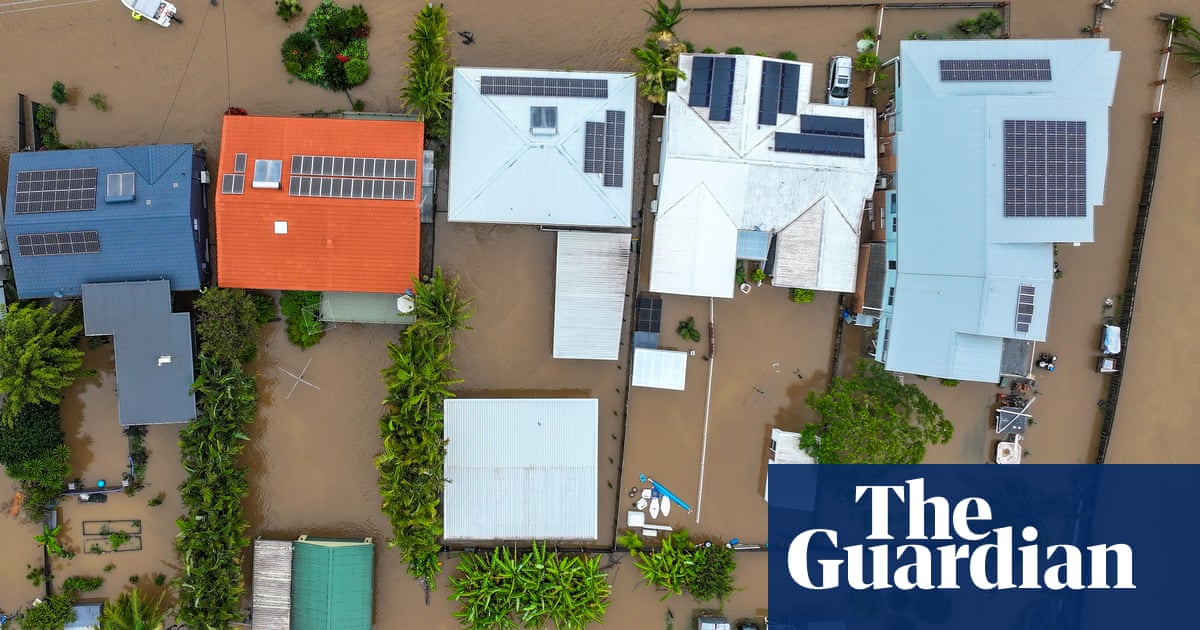A reprieve from heavy rainfall is expected to arrive on the NSW mid north coast on Friday after three days of flooding, as authorities desperately search for a missing man with three people confirmed dead.
Residents in the region are hoping for easing conditions on Friday after the NSW premier, Chris Minns said on Thursday flooding had “smashed through” communities with “levels of rise in local tributaries, creeks [and] rivers that we haven’t seen since 1920”.
“Many people would have never seen this level of inundation or flooding in their communities,” Minns said.
The bodies of three people have been found since the flooding: a man found in Rosewood likely in his 30s missing since Wednesday night, a 63-year-old man at a home in Moto, and a 60-year-old woman who was caught in flood water travelling from Sydney to Coffs Harbour in a 4WD on Wednesday night.
A 49-year-old man who failed to come home after walking near a flooded road at Nymboida is still missing.
The NSW State Emergency Service said on Thursday afternoon that 48,000 people still remained isolated by flood waters in the region.
According to the Bureau of Meteorology, after rain of up to half a metre in some places since Sunday, there is expected to be a reprieve on Friday, as the coastal trough moves south towards the Victorian border.
The bureau said conditions were set to ease during Thursday night, with rainfall shifting to parts of the southern Hunter, Blue Mountains and Southern Highlands. On Friday morning, heavy rainfall will extend further south to the Southern Tablelands and inland parts of the south coast.
For the mid-north coast, there was expected to be isolated areas of heavy rainfall leading to flash flooding up until midnight, with six-hourly totals of between 60mm and 100mm of rain likely.
As the system moves down the coast, it is not expected to have the same level of flooding, but up to 100mm of rain over 24 hours are expected in those areas.
Major flooding is occurring on the Manning, Paterson, Hastings, Williams, Nambucca and Macleay Rivers. Renewed river rises were likely into the weekend, the NSW SES assistant commissioner Dean Storey said.
“Although rainfall may be reprieving in some areas, we haven’t seen the end of renewed river rises in northern NSW and people should not become complacent,” Storey said.
There were 149 active warnings on Thursday evening, with 37 at emergency warning, and 86 at watch and act.
There had been more than 4,600 calls for assistance recorded, and 600 flood rescues utilising nine helicopters, 500 boats and ground crew. There were 2,500 personnel, including 2,200 SES workers, in the field.
Telecommunications services had been affected by the flooding, but the NSW SES had been door-knocking residents in the affected areas.
There are 15 evacuation centres open, including at Dungog, Gloucester, Taree, Wingham, Kempsey, Coffs Harbour and Port Macquarie.
Emergency services personnel from Victoria were travelling to NSW on Thursday night to assist in the response, with 24 en route including staff from the Victorian SES, Fire Rescue Victoria and the Country Fire Authority.
On Thursday evening, NSW police northern regions commander David Waddell announced the third reported death in the floods, which have been brought on by three consecutive days of rain.
He said the woman, who was yet to be formally identified, was located in Brooklana, west of Coffs Harbour. Her family has been informed.
Police earlier said a body, believed to be that of a man in his 30s missing since Wednesday night, was found near Rosewood on Thursday morning. The body of a 63-year-old man was found on Wednesday at a home affected by flood waters on North Moto Road at Moto.
The 60-year-old woman had travelled with a police officer towards Coffs Harbour at 7pm on Wednesday night until they reached flood waters at Wild Cattle Creek Bridge. The officer was in a BMW sedan and could not continue. The woman was in a 4WD and decided to continue after the officer checked the water levels, Wardell said.
The woman called 30 minutes later saying she was in trouble near Brooklana, but could not be located after a search. Her vehicle was found at 2pm on Thursday.
Waddell pleaded with people not to enter the flood waters.
“It is a really dangerous, once-in-a-lifetime event, and there’s been some tragedy surrounding this death, obviously, the police officer who spoke the woman is very traumatised, and we’re wrapping support services around him.”
The federal government activated disaster recovery allowance for people who live or work in the Kempsey, Port Macquarie-Hastings, Mid-Coast, Dungog local government areas, available from 2pm Monday 26 May.
People who have lost income as a direct result of the event may be eligible for up to 13 weeks of income support for workers and sole traders. Claims can be made online through myGov or the myGov app.
This is in addition to the joint federal and state disaster recovery funding available across 16 local government areas, which is administered by the NSW government.
Mutual obligation requirements have been suspended for job seekers in the Hunter region and the mid north coast until 29 May. The federal government also said people who need to change or pause Centrelink debt payments can do so online or in the mobile app, or by calling 1800 076 07.
